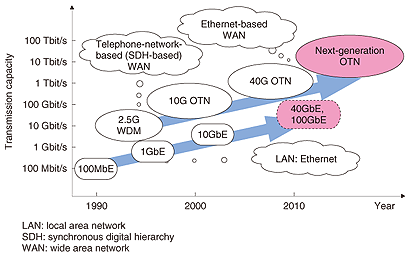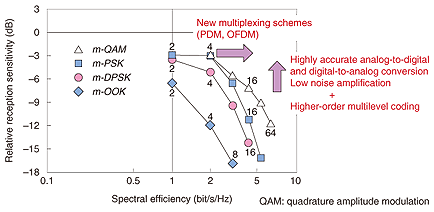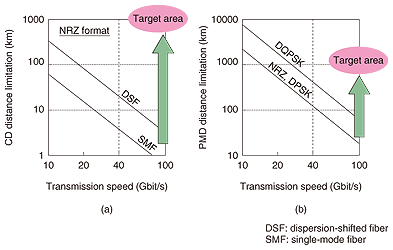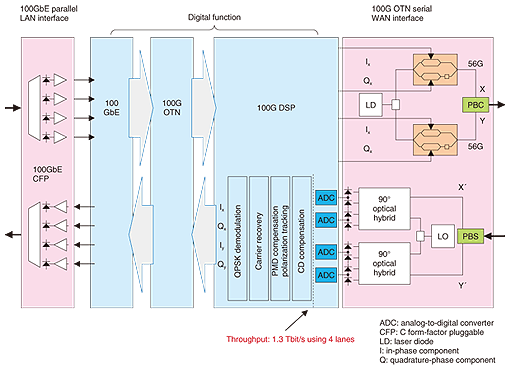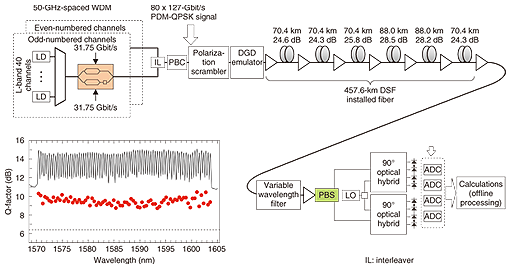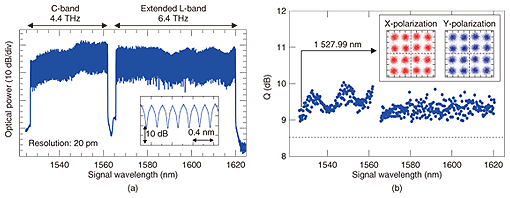 |
|||||||||||||||||||||
|
|
|||||||||||||||||||||
|
Feature Articles: Ultrahigh-speed Ultrahigh-capacity Optical Transport Network Vol. 9, No. 8, pp. 14–20, Aug. 2011. https://doi.org/10.53829/ntr201108fa2 Ultrahigh-capacity Digital Coherent Optical Transmission TechnologyAbstractIn this article, we introduce the current progress in ultrahigh-capacity digital coherent optical transmission technology that will support future broadband networks. It enables great improvements in optical transmission performance through the use of ultrahigh-speed digital signal processing and will lead to capacities exceeding 10 Tbit/s per optical fiber.
1. IntroductionDigital coherent optical transmission technology is a key technology that can greatly improve the transmission performance of optical fiber by incorporating ultrahigh-speed digital signal processing (DSP) into optical communications. In the Optical Transport Network (OTN), various client signals such as those of 40G and 100G Ethernet (40GbE and 100GbE; G denotes Gbit/s) are accommodated in an ultrahigh-speed optical channel at the line rate of 112 Gbit/s per wavelength. As a result, highly reliable long-distance high-capacity transmission is achieved. 2. High-capacity optical networks based on ultrahigh-speed channel transmission technologyIn the future OTN, 10-Tbit/s-class optical networks will be achieved using 100G optical channels with a frequency spacing of 50 GHz [1] (Fig. 1). Furthermore, by using optical switches having multidegree reconfigurable optical add/drop multiplexers (ROADMs) in intermediate optical nodes, it is possible to enhance the scalability of optical networks significantly. In 2006, we successfully conducted a 14-Tbit/s wavelength division multiplexing (WDM) transmission experiment that demonstrated for the first time the feasibility of a 10-Tbit/s-class OTN, in which 100-Gbit/s-class optical channels can transparently transport 100GE signals. We used polarization-division-multiplexed return-to-zero differential-quadrature-phase-shift-keying direct detection (PDM-RZ-DQPSK-DD) systems [2]. In order to achieve highly reliable 100-Gbit/s-channel-based high-capacity systems having backward compatibility with existing systems, the following technological issues must be resolved. - Improve the signal-to-noise ratio (SNR) and spectral efficiency (SE) - Improve chromatic dispersion (CD) tolerance and polarization mode dispersion (PMD) tolerance - Improve the tolerance to spectral filtering induced by the optical nodes - Improve optical fiber nonlinear tolerance For increased transmission capacity, multilevel modulation formats are attractive for enhancing the SE, the same as in wireless communications. However, when considering a multilevel format with the number of levels m equal to or higher than 4, as shown in Fig. 2, we must increase the total system SNR to achieve the same regenerative repeater spacing. This is because the required SNR of a higher-level multilevel format (m>4) is higher than that of QPSK (m=4). For this purpose, it is promising to combine new multiplexing/demultiplexing schemes such as PDM and OFDM (orthogonal frequency division multiplexing) with a multilevel format to enhance both the SNR and SE simultaneously.
3. Digital coherent optical transmission technology: overview and advantagesIntroducing digital signal processing to optical communications provides three main advantages. (1) Coherent detection enables a high-sensitivity receiver that utilizes the frequency and phase of an optical carrier signal. Long-haul transmission can be achieved, since a 3-dB improvement in the SNR can be achieved compared with conventional intensity modulation direct detection. (2) Powerful digital equalization of the linear waveform distortion caused by CD and PMD has been achieved by using DSP; such strong equalization cannot be used in conventional receivers. This feature greatly simplifies the operation and configuration of optical amplifier repeater systems. (3) DSP-aided highly reliable PDM can be introduced into high-capacity optical transmission systems, and the SE can be improved by more than two fold compared with conventional systems. The relationship between the optical signal transmission speed and the transmission distance limited by CD and PMD is shown in Fig. 3. The CD limit is caused by waveform distortion originating from the group velocity dispersion of the optical frequency, and the achievable transmission distance decreases in inverse proportion to the square of the data bitrate. For example, as shown in Fig. 3(a), in the case of the typical binary non-return-to-zero (NRZ) intensity modulation format, the transmission distance is limited to less than 10 km at a data rate of 100 Gbit/s. PMD is closely related to the birefringence caused by the anisotropy of the core diameter during the manufacturing process and the stress imposed during the installation and operation of fiber cables. There are two independent states of signal polarization in the fiber in the presence of PMD. Their signal propagation delays (differential group delays (DGDs)) are slightly different from each other and they vary with time. Therefore, owing to the fluctuation of the incident signal polarization and DGD, the waveform distortion has dynamic characteristics. Such dynamic waveform distortion is dominant at transmission speeds higher than 40 Gbit/s. To mitigate these issues, RZ-DQPSK-DD was used in a 40-Gbit/s-channel WDM system, where the PMD tolerance was enhanced and the SE was improved to 0.4 bit/s/Hz compared with that for binary code. A 1.6-Tbit/s-per-fiber transmission system with a regenerative repeater spacing of more than 500 km has been implemented [3]. At data rates over 100 Gbit/s, however, the PMD-limited transmission distance is less than 100 km, even if RZ-DQPSK-DD is used, as shown in Fig. 3(b). As a promising candidate for overcoming this limitation, DSP-aided coherent detection systems (i.e., digital coherent systems) have recently attracted much attention. Digital coherent systems fully utilize previously unused properties of the optical signal, such as phase, frequency, and polarization. By adaptively mitigating waveform distortions caused by CD and PMD, a regenerative repeater spacing of greater than 1000 km is expected in long-distance transmission with capacities higher than 10 Tbit/s per fiber core. The basic configuration is shown in Fig. 4. In the coherent optical communications scheme, wireless homodyne detection*1 and heterodyne detection*2 are performed similarly, and a local oscillator (LO) is provided in the receiver. The received optical signal and its beat signal are converted into baseband or intermediate-frequency-band electrical signals and the received equalized waveform is regenerated. Since these detection schemes enable highly sensitive detection and large CD/PMD compensation in an electrical intermediate frequency band, these technologies were actively investigated up to approximately twenty years ago. However, at that time, there were significant issues with the conventional coherent optical communications systems: (1) the physical synchronization of the frequency and phase between the received signal and LO light and (2) the polari–zation tracking at the optical level. The introduction of a digital signal processor (DSP) at the coherent receiver enables high-speed electrical synchronization between the receiver signal and the LO, so high-speed polarization tracking can be performed in real time in the digital domain. Since the adaptive digital filter in the DSP compensates for the dynamic waveform distortion due to CD and PMD through the optical fiber, we can greatly improve the distance limit in ultrahigh-speed signal transmission at a data rate of 100 Gbit/s.
4. Component technologies for digital coherent optical transmissionOne critical issue in achieving the abovementioned digital coherent transmission is achieving DSP with high-speed analog-to-digital (A/D) and digital-to-analog conversion. Let us consider the PDM-QPSK format as an example for a 112-Gbit/s digital coherent system. The 112-Gbit/s PDM-QPSK signal consists of two polarization components, on the X and Y axes, and each polarization signal is independently modulated by 56-Gbit/s QPSK by using a nested Mach-Zehnder modulator (MZM). As a result, the symbol rate is 28 Gsymbol/s. At the transmitter, the signal is transmitted as a QPSK optical signal, which uses the same modulator configuration as in the DQPSK-DD system. Independently modulated 56-Gbit/s QPSK signals are polarization multiplexed using a polarization beam combiner (PBC) to form a 112-Gbit/s PDM-QPSK optical signal. In optical fiber transmission, the polarization states are not maintained after transmission because of temperature changes in the fiber cable and physical contact with the fiber by an operator. At the receiver, the PDM QPSK signal is separated into X′ and Y′ polarization components at the polarization beam splitter (PBS). These signals pass through a 90° optical hybrid and differently polarized signals are separated into in-phase and quadrature-phase components by coupling them with the LO signal, for each polarization axis (X′, Y′). A/D converters convert the 112-Gbit/s received signal into 4-lane 28-Gsymbol/s electrical digital signals. In the DSP part, after synchronization between the received signal light and the LO signal, CD compensation, polarization demultiplexing, PMD compensation, and carrier phase recovery are conducted to demodulate the original 112-Gbit/s PDM-QPSK signal in the digital domain. DSP throughput greater than 1.3 Tbit/s is required for 112-Gbit/s digital coherent systems (e.g., for each lane with a 28-Gsymbol/s received waveform, six quantizing bits, and a sampling rate of 2 samples/symbol, the throughput per lane is 336 Gbit/s; thus, for all four lanes, 1.344-Tbit/s digital signal processing is required). In recent years, several developments have advanced realtime DSP technology, leading to innovations in 100-Gbit/s class transmission performance and we anticipate further progress in the future. We will accelerate our research efforts for realtime digital coherent optical transmission technology; the key concept of the DSP architecture has been studied under the Universal Link Project supported by the National Institute of Information and Communication Technology (NICT) of Japan [4]. Proof-of-concept studies for 100-Gbit/s-class digital signal processing are also being conducted in a project supported by the Ministry of Internal Affairs and Communications of Japan [5]. 5. Field trials of 100-Gbit/s digital coherent schemeTo confirm the feasibility of this scheme, we conducted a 8-Tbit/s field experiment using 80 °Ŗ 100-Gbit/s DWDM (dense WDM) test signals over an installed dispersion shifted fiber (DSF) [6]. The experimental setup is shown in Fig. 5. In this experiment, the line rate was set to 127 Gbit/s to improve the optical SNR by introducing strong forward error correction (Ultra FEC (UFEC)) with 20% redundancy. An 8-Tbit/s test signal was generated to wavelength-division-multiplex 80 channels of 127-Gbit/s PDM-QPSK signals with a 50-GHz spacing. A polarization scrambler and a DGD emulator were arranged at the transmitter output to simulate various polarization conditions and PMD. The transmission line used in the experiment comprises an 8.8-km 100-core slotted-core DSF cable with dozens of connectors constructed between NTT Yokosuka R&D Center and NTT EAST°«s Yokosuka office. The test wavelengths were from 1570.4 nm to 1603.6 nm in the L band. The 457.6-km line with L-band erbium-doped fiber amplifier (EDFA) inline repeaters has four spans of 70.4 km and two spans of 88.0 km. Its CD coefficient ranged from 1.4 to 4.2 ps/nm/km, the PMD coefficient was less than 0.2 ps/km0.5, and the loss in each span ranged from 24.3 to 28.5 dB. A tunable wavelength light source with a line width of 100 kHz was used as an LO in the digital coherent receiver. For digital signal processing, offline processing was performed using a computer and a realtime oscilloscope. The CD and PMD in the transmission line were completely compensated for by digital signal processing in the receiver, and inline dispersion compensation at each optical amplification repeater was not used. The 8-Tbit/s (127 Gbit/s × 80 channels) WDM spectra and the error rate for all channels (Q factor) after 457.6-km transmission are shown in Fig. 5. For all the channels, Q factors of more than 8.5 dB were obtained; that is, they were all above the UFEC limit of 6.4 dB. Thus, we confirmed the feasibility of transmitting a stable 8-Tbit/s signal over an installed DSF.
6. Challenges toward achieving higher capacitiesWe investigated the feasibility of much higher capacities with higher SE of more than 2 bit/s/Hz by using enhanced DSP based on higher-order multilevel quadrature amplitude modulation (QAM) formats. We successfully achieved 69-Tbit/s DWDM transmission over a distance of 240 km by using 171-Gbit/s PDM-16QAM [7]. This advanced DSP scheme enhances the phase noise tolerance required in order to use PDM-16QAM. The test results are shown in Fig. 6. In this experiment, we used hybrid EDFA/Raman optical amplification in three 80-km spans of ultralow pure-silica core fiber with fiber loss of 0.16 dB/km. As a result, we achieved low-noise signal transmission with bandwidth of more than 10.8 THz covering the C band (1527.22–1562.03 nm) and an expanded L band (1565.91–1619.84 nm) that compensated for the reduction in optical SNR tolerance caused by using the 16QAM format. The redundancy of the enhanced FEC (E-FEC) was 7%. As a result, we successfully achieved ultrahigh-capacity transmission of more than 10 Tbit/s with a high SE of 6.4 bit/s/Hz.
7. SummaryIn this article, we introduced the latest technical trends in ultrahigh-capacity digital coherent transmission technologies for future optical transport networks that support broadband network evolution. We will continue research and development of a practical 10-Tbit/s-class OTN. References
|
|||||||||||||||||||||








